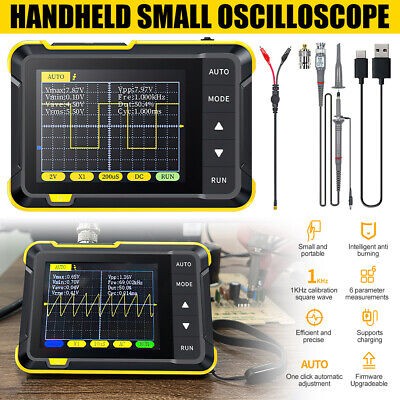For Mercedes-Benz technicians and enthusiasts using Xentry, the diagnostic software suite, understanding the full picture of vehicle health requires more than just software readouts. While Xentry excels at providing Diagnostic Trouble Codes (DTCs) and guided diagnostics, an automotive oscilloscope, sometimes referred to as an “Xentry Scope,” becomes an indispensable tool for pinpointing elusive electrical faults, especially within the complex Controller Area Network (CAN bus) systems of modern Mercedes vehicles.
Why Integrate an Oscilloscope with Your Xentry Diagnostics?
Xentry is powerful, but it primarily interprets data and reports anomalies based on pre-programmed parameters. When communication issues arise within the CAN bus, Xentry might flag a “missing message” DTC. However, it often stops short of revealing the root cause of this missing message. This is where an oscilloscope shines.
As one seasoned technician pointed out, “Xentry will tell you via a DTC there is a ‘missing message’ but won’t tell you why, using a scope you can ‘see’ why.” An automotive oscilloscope allows you to visualize electrical signals in real-time, directly on the wiring. This capability is crucial for:
- Identifying CAN Bus Issues: Corrosion, a common culprit in Mercedes CAN concentrator strips, can disrupt signal integrity. An oscilloscope can visually confirm signal degradation or complete signal loss, leading you directly to the problematic area. Simply opening up the CAN concentrator PCB and probing with a scope can reveal color changes in soldered joints indicative of corrosion, which Xentry software alone cannot detect.
- Verifying Communication Integrity: CAN bus systems are bidirectional communication channels. An oscilloscope allows you to monitor both transmitted and received signals. You can even isolate modules by disconnecting them from the CAN bus and observe if they are still “talking” or causing interference. This level of signal analysis is far beyond the capabilities of diagnostic software.
- Pinpointing Intermittent Faults: Oscilloscopes can capture transient signal anomalies that might be missed by standard diagnostic scans. These intermittent issues can be notoriously difficult to diagnose with software alone, making a scope essential for resolving them efficiently.
Oscilloscope Recommendations for Xentry Users
Choosing the right oscilloscope depends on your diagnostic needs and budget. Here are a couple of options based on different requirements:
For Basic Electrical Checks and Entry-Level Diagnostics:
If you’re looking for an affordable entry point into oscilloscope diagnostics, consider a handheld digital oscilloscope like the FNIRSI DSO152. As one user mentioned, “for its price it’s basically an improved multimeter…it’s been handy checking crank sensors etc.”
 FNIRSI DSO152 Handheld Digital Oscilloscope
FNIRSI DSO152 Handheld Digital Oscilloscope
While not designed for high-speed CAN analysis, the DSO152 is sufficient for basic signal checks, sensor testing, and initial fault isolation. Its portability and low cost make it a valuable addition to any toolkit, especially for technicians who want a quick and convenient way to visualize electrical signals without investing in a high-end, benchtop oscilloscope.
For Advanced CAN Bus Diagnostics and Comprehensive Analysis:
For professionals tackling complex CAN bus issues and requiring in-depth signal analysis, a more capable oscilloscope is necessary. While the original forum post didn’t specify particular models beyond a high-end “£5k Keysight” and a user mentioning a single channel scope around £100 (unspecified brand), reputable brands in automotive oscilloscopes include:
- PicoScope: Known for their PC-based oscilloscopes that offer excellent software, multiple channels, and advanced analysis features.
- Autel MaxiScope: Designed specifically for automotive diagnostics, integrating seamlessly with Autel diagnostic scanners and offering user-friendly interfaces.
- Snap-on: A trusted brand in automotive tools, offering robust and reliable oscilloscopes with comprehensive diagnostic capabilities.
- Keysight/Agilent: High-end, professional-grade oscilloscopes offering top-tier performance and features, suitable for the most demanding diagnostic scenarios (as referenced by a user with a “£5k Keysight”).
When selecting a professional-grade “Xentry scope,” consider factors like:
- Number of Channels: Multiple channels (2 or 4) are essential for comparing signals simultaneously and analyzing complex circuits.
- Bandwidth: Higher bandwidth is crucial for capturing fast signals in CAN bus systems and other high-speed networks.
- Sampling Rate: A higher sampling rate ensures accurate representation of fast-changing signals.
- Software and Features: User-friendly software with advanced triggering, measurement, and analysis capabilities is vital for efficient diagnostics.
Conclusion: Amplify Your Xentry with an Oscilloscope
In conclusion, while Xentry provides extensive diagnostic capabilities for Mercedes-Benz vehicles, integrating an oscilloscope into your diagnostic workflow elevates your troubleshooting abilities to a new level. Whether you opt for a budget-friendly handheld scope for basic checks or invest in a professional-grade instrument for advanced CAN bus analysis, an “Xentry scope” empowers you to visualize electrical signals, pinpoint root causes, and resolve complex issues that software alone might miss. By combining the diagnostic power of Xentry with the visual insight of an oscilloscope, you can achieve faster, more accurate, and more effective Mercedes-Benz repairs.